A 360 degree journey into the Ugandan pig value chain
15 Nov 2017, Posted by in News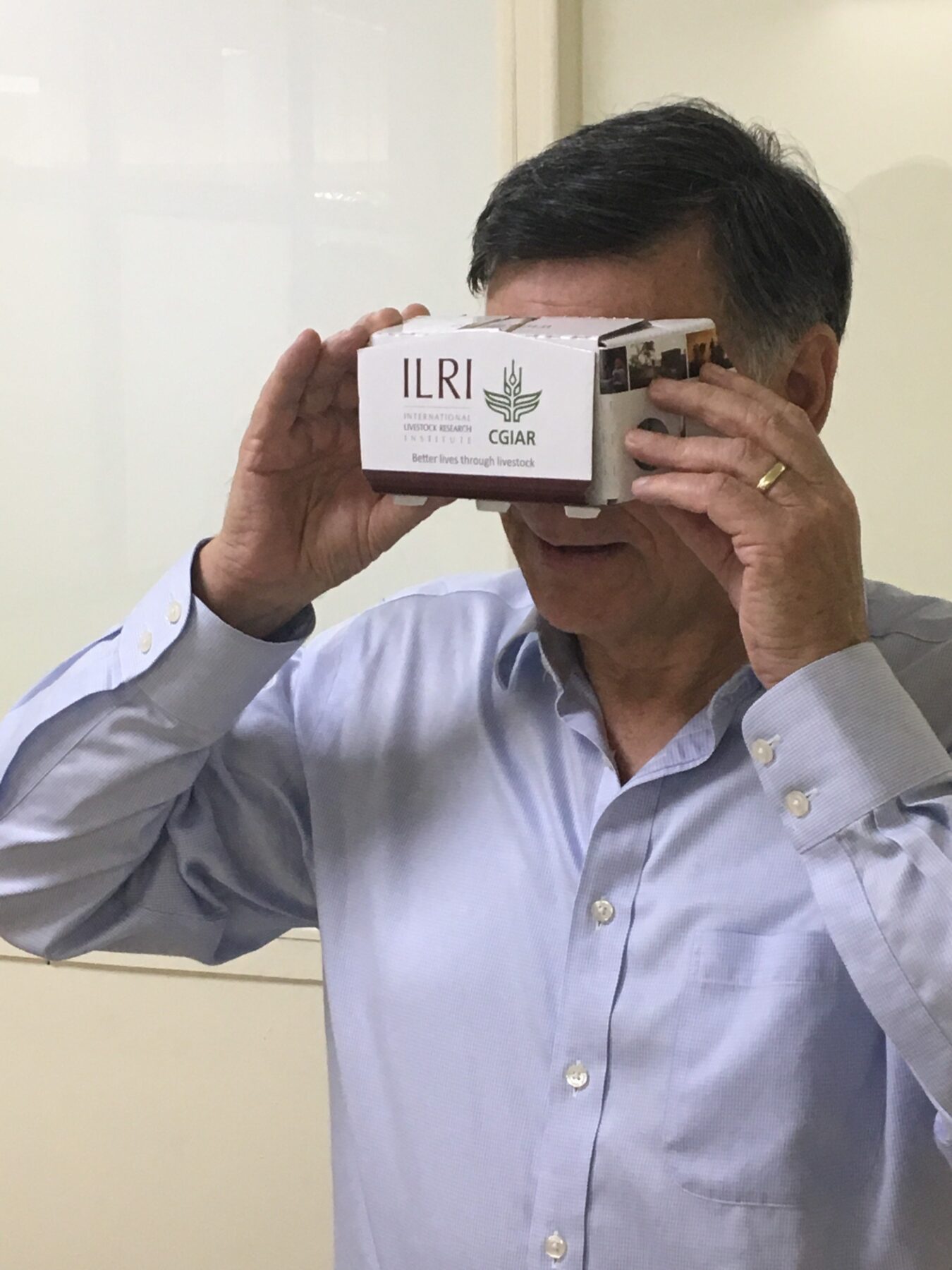
This story is based on the story originally written for IRLI by Brian Kawuma, Manon Koningstein, Neza Skorc and Iddo Dror
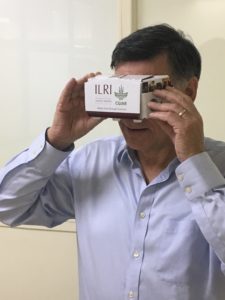
Prof. Lindsay Falvey, Chair, ILRI Board of Trustees, watching the Uganda Pig Value Chain film in 360⁰. (Photo: ILRI)
As part of ILRI’s quest to pilot new technologies for better communication of its work, the first-ever CGIAR 360⁰’ video was produced, offering a glance into an ordinary day of a pig farmer, trader or consumer as part of the Smallholder Pig Value Chains implemented in Uganda.
´We are always looking at how new technologies can enhance our work. In the case of 360’ videos, we saw an opportunity to provide a rich, immersive viewing experience, that would allow visitors to our campuses in Kenya and Ethiopia to have ‘virtual visits’ to other areas where ILRI works that they would normally not be able to visit/experience.´ Iddo Dror, Head of Capacity Development at ILRI.
360⁰ Filming
In practical terms, 360 degree filmmaking means that the viewer literally gets a 360 look around and even gets to decide where to look. In words of Manon Koningstein, from Sivin Communications: ‘we make it so our audience can experience the story from the field, understand it better and thus act on it. The idea behind this is that if you involve the audience more, you might be able to make them feel more.’ So, when we first started brainstorming about how we could use 360 video within ILRI I knew right from the beginning that this could be the start of a new movement of how we reach our audience and how we communicate the work that is done by ILRI in the field and with 360 technology still new and experimental, yet more accessible it seems to be the perfect time´.
Storytelling through 360 video
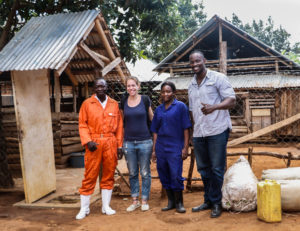
Manon Koningstein from Sivin Communications and Brian Kawuma from ILRI while filming 360´shots in Masaka, Uganda.
Manon continues explaining that 360 degree video really provides the opportunity to bring the audience right to the communities and people they would otherwise not have access to. All of a sudden we can now see where the farmer gets his pig feeds, where the pigs are in relation to his house, that the butcher stalls are right next to a big road and the way they attract their customers. 360 video will make the change from bringing the farmers stories into our space, to actually bringing the audience into their space, and this way, changing the whole hierarchy. We make that our audience can experience the story from the field, understand it better and thus act on it.
Value chain project in Uganda
Pig production is a major source of livelihoods for over 1.1 million households in Uganda. The CRP on Livestock identified the smallholder pig value chain in Uganda as a high potential target to translate research into major interventions that stimulate pro-poor transformation and generate benefits at scale. Supported with funding from the CRP on Livestock, IFAD-EC and Irish Aid, the smallholder pig value chain development projects’ research interventions were implemented in five Ugandan districts.
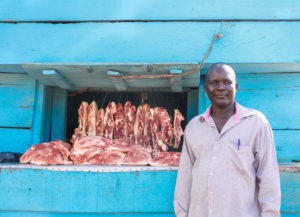
Okurut, a pork trader from Mukono district, attended a participatory butcher training by ILRI in Mukono, Uganda. Photo: Manon Koningstein
The film was shot in Masaka and Mukono districts, two of the five sites where the research projects have been implemented in Uganda. The filming team interviewed pork butchers, traders, pig farmers and representatives of the district local governments.
Challenges and lessons learnt
Since the very beginning, the team expected different challenges to overcome that had mostly to do with getting used to new equipment and new filming rules that come with it, such as:
Making sure that the scene were long enough for the audience to have look around without feeling rushed on the one hand, and not too long on the other in order to prevent the viewers from feeling bored. This links to the length of the scenes. Where in normal film we want to change the scenes quite quickly to avoid the audience become bored, in 360 degree film you need to give your audience the opportunity to actually look around without feeling rushed, however, the old rules such as the need to have their attention captured in the first three to five seconds, and they need to feel like the video has a conclusion when they reach its end still apply.
Using a tripod or a gimbal to keep the video steady and decrease the risk for the viewers to experience motion sickness, which is a common risk with 360’ videos as the viewers sees the moving surface, but the brain does not detect it.
Keeping the scenes looking natural — the camera can draw a lot of attention from people passing by, which can result in forming of curious crowds and not getting the ‘a normal day’ shot. However, since the camera is very small it did not attract as much attention as we thought and in the situations where it did, we would usually set it up and let it roll for a minute or two for everyone to get back to their daily activities, and after this we would take the actual shot.
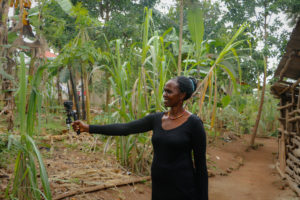
Beatrice, a pig farmer tries out the 360⁰ camera using a gimbal at her farm in Masaka, Uganda. Photo: Manon Koningstein
And this is just the beginning…
The video was first shown to ILRI board members in October 2017, and was well received .
´We are delighted to have our 360’ video live – a first for a CGIAR Research Center – and to allow our viewers to get a glimpse into the Uganda pig value chain work´, Iddo mentions. ‘And we are already thinking of next steps: we would like to have a few more such videos that would capture the breadth of ILRI’s work. As the technology advances, we may look into virtual reality and augmented reality add-on as well.’
Thanks to the team
Of course, the process of this 360 filmmaking would have been impossible without the help of the amazing team, consisting of Iddo Dror, Philip Sambati, Neza Skorc, Ben Lukuyu and Emily Ouma and Jennifer Kinuthia for their overall support and their help with the project management, Brian Kawuma for his help with the shooting and translation on the field, Susan Macmillan for her help with the script and the narration, Shelley Takral for her help with the script, Brenda Onyutta for her beautiful voice over, Dmitri Lapchinski for the final editing and above all the local authorities, pig farmers and butchers in the sites we filmed.

[…] We made a wonderful 360 degree movie for the International Livestock Research Institute (ILRI) that you can read all about here […]